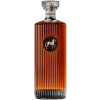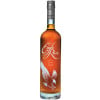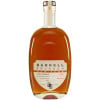About St. George 200mL Gins
Founded in 1982 by German-born Jörg Rupf, St. George Spirits is one of the oldest craft distilleries in the United States. The distillery, housed in an old World War II airplane hangar on a former naval base on the edge of San Francisco, is home to Lance Winters, mad scientist and St. George's master distiller.
Winters, who is widely-known for experimenting with different types of spirits, has a laboratory dominated by a 10-liter test still in addition to the glass beakers and graduated cylinders that cover every inch of counterspace. Next to the dusty chalkboards caked with equations for the conversion of sugar to alcohol and intricate diagrams of molecular structures are bottles of experimental whiskies, vodkas and even an aging balsamic vinegar (it's 14 years old already).
This feature represents three unique expressions of gins produced by one of America's most creative craft distilleries.
Made using juniper, Douglas Fir, California bay laurel, coastal sage and coriander seeds, along with a number of other herbs and botanicals, St. George Terroir Gin is a true California Gin. The coriander seeds are roasted inside a well-seasoned wok, which contributes an earthy, aromatic bouquet to the gin. In addition, the Douglas Fir and coastal sage are distilled individually through Winters' 250-liter copper-pot still, which minimizes seasonal configurables in the botanicals. Finally, while the fresh bay laurel leaves and juniper berries are infused through the still's botanical basket, the remainder of the botanicals are placed directly in the pot, resulting in a cleaner and crisper flavor.
St. George Terroir Gin has a stunning bouquet of fresh, forest aromas, including pine and oak. The woodsy notes are complemented by bursts of juniper and sage, and lead to a crisp finish. St. George Terroir is "spectacularly evocative"according to
Food and Wine Magazine, and "one of the most distinctive gins made in America"according to
GQ Magazine.
St. George Botanivore Gin — a botanical eater of a gin — is infused with 19 different herbs and botanicals, including angelica root, bay laurel, bergamot peel, black peppercorn, caraway, cardamom, cilantro, cinnamon, citra hops, coriander, dill seed, fennel seed, ginger, juniper berries, lemon peel, lime peel, orris root, Seville orange peel and star anise.
While the juniper, bay laurel and fresh cilantro are added to the gin's botanical basket, the other 16 botanicals are steeped overnight in the copper-pot still. Then, gentle steam heat is added to the still, in order to coax out the flavors and aromas of the herbs and botanicals.
Fresh and slightly herbaceous, St. George Botanivore Gin has bright notes of citrus, earth and spice that are complimented by subtle floral undertones. The gin earned a score of 93 points from Wine Enthusiast Magazine, which selected it as one of the Top 50 Spirits of 2012. In addition, Park and Bond wrote that it was "a sunshine-drenched greenhouse of a spirit"while Esquire called it "complex and bright."
St. George Dry Rye Gin is made using an unaged rye as the base spirit, giving the gin its warm and malty flavor. The gin is then infused with just six botanicals, including juniper, black peppercorn, caraway, coriander, grapefruit peel and lime peel.
The gin has warm, peppery flavors with a hint of underlying citrus.
Playboy Magazine said that St. George Dry Rye Gin was the "slightly sweet and subtly spicy version that shines all on its own,"while
The Washington Post said that it was "something like a cross between traditional London dry and a rye whiskey,"adding that it was "absolutely amazing in Negronis."
This pack of gins represent three unique expressions by one of America's most creative craft distilleries. Pick up all three today!
About Gin
According to Winston Churchill, "The gin and tonic has saved more Englishmen's lives and minds than all the doctors in the Empire," referring to the British officers using it to treat malaria in India.
Initially made for medicinal purposes, gin gets most of its flavor from the juniper berries added after the distillation process. It sure has come a long way from the Middle Ages, with the introduction of new botanicals, fruits, and spices, bringing it closer to people of all flavor varieties.
Check out our impressive selection of gins, find your new favorite in the Top 10 gins, or explore the Best gins under $50.











